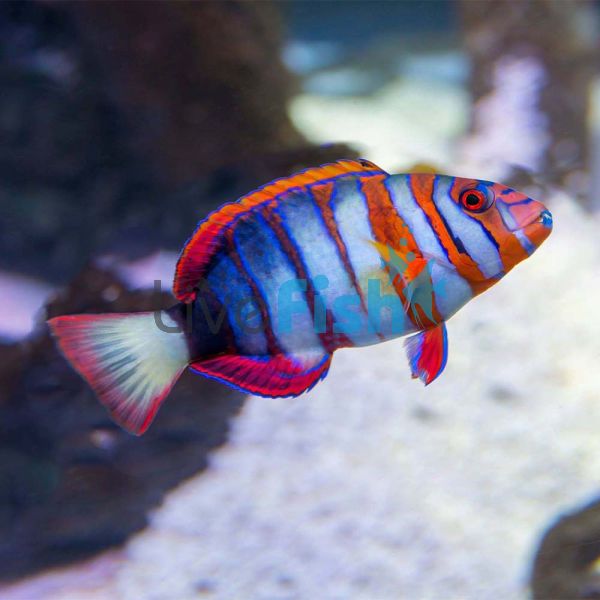Harlequin Tusk Wrasse - Medium
This unusual-looking wrasse has a combination of stunning bright colours. It is surprisingly resilient and adapts well to aquarium life.
The Harlequin Tusk Wrasse gets its name from its "harlequin" colours and its teeth. The four front teeth resemble little tusks, and as the fish matures, they will turn dark blue. These teeth are used to pierce and tear the exoskeletons of invertebrates. This species has a different colouration depending on the region it's from. Tusks from the Indian Ocean feature orange stripes with white edges and a hint of blue near the tail. Australian Tusks have orange stripes with brilliant blue borders. The stripes start at the pectoral fin and run all the way back to the tail. Once mature an adult can grow to a length of 10 inches (25.4 centimetres) in length.
There is very little information on this species' reproductive habits. Harlequin Tuskfish are protogynous hermaphrodites. This means that all fry is born female and can change their sex to male. According to reports, their social group is usually harems. The largest female will typically change sex as it matures or if a need for a male emerges.
This species can be found in two locations in the western Pacific Ocean. The first location runs from the Ryukyus to Taiwan. The second location runs from Queensland, Australia, to New Caledonia. This species can be found in reefs with depths ranging from 5 to 35 meters (16 to 115 ft).
Tank Recommendations for your Harlequin Tusk Wrasse
Recommended tank size is a minimum of 125 gallons (473.2 litres)
Caution is advised if housing this species in a reef environment. They won't threaten corals, but they will consume small crustaceans.
They will make fantastic addition to a FOWLR (Fish Only With Live Rock) aquarium. Your tank should contain plenty of live rock with caves and crevices for hiding and shelter.
Suitable Tank Buddies
These fish are shy at a young age, but as they get older, they get more adventurous.
This species isn't suitable to cohabit with conspecifics unless a tank is very large. In most circumstances, only one specimen should be kept in each tank. They should be introduced first to avoid disputes over territory.
Usually Compatible
Suitable companions would be semi-aggressive, energetic fish like Tangs, Angelfish, and smaller Triggerfish.
Sometime Compatible
Wrasse should be monitored if cohabiting with certain species. These include conspecifics, Squirrelfish, Batfish, Hogfish, Eels, Dartfish, and Pufferfish.
Rarely Compatible
Wrasses aren't easily threatened by other species. However, they can pose a threat to crustaceans and slow movers such as Seahorses.
Feeding your Harlequin Tusk Wrasse
The Harlequin Tusk Wrasse is carnivorous. Its diet should be varied. Fish, gelatin formulae, and invertebrates such as shrimp, prawns, and krill are recommended. Food flakes and pellets may also be incorporated into its diet. Any food served should be cut into small bite-size pieces. Feed 2-3 times a day.
| Scientific Name | Choerodon fasciatus |
|---|---|
| Care Level | Moderate |
| Common Names | Harlequin Tusk Wrasse, Harlequin Tuskfish, |
| Diet | Carnivore |
| Fish Family | Labridae |
| Lifespan (years) | 10 |
| Max. Length (cm) | 25 |
| Min. Tank Volume (l) | 473 |
| Origin | Western Pacific Ocean; Ryukyus, Taiwan, Queensland, Australia, New Caledonia |
| Reef Safe | With Caution |
| Sociability | Semi-aggressive |
| Venomous | No |
| Water Conditions | 1.020-1.025, 22.2 - 25.5°C , dKH 8-12, pH 8.1-8.4 |




